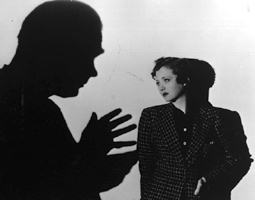

UK suspense
1936
bw 76 min.
Director: Alfred Hitchcock
CLV: $34.95 - available
1 disc, catalog # CC1117L

Alfred Hitchcock
committed a shocking murder in Sabotage (1936). Here, in one of the
director's darkest works, a child unknowingly carrying a bomb is blown to pieces
in the streets of London. The death of Stevie is a deliberate attempt to shock an
audience not accustomed to elaborately orchestrated deaths of sympathetic
characters -- especially children. The crime defeats expectation so decisively
that it is virtually an act of cinematic terrorism. Means: a saboteur scenario
based on The Secret Agent by Joseph Conrad (not to be confused with
Hitchcock's Secret Agent, adapted earlier the same year from a different
text, or Saboteur, a 1942 American production). Motive: the death is part
of a larger meditation on evil, one in which every major character is killed,
morally compromised, or both. Opportunity: with the popular successes of The
Man Who Knew Too Much (1934) and The Thirty-Nine Steps (1935),
Hitchcock could do as he pleased.
The saboteur's first strike is a London power
failure (Chapter 1). It's eloquent, economical filmmaking: the flickering bulb,
the quivering power meter, sand in the generator and on the hands of the guilty
Verloc (Oscar Homolka). The boy, Stevie (Desmond Tester), is introduced as a
butterfingered menace in the kitchen of the living quarters behind Verloc's
cinema. His lovable clumsiness later proves fatal. Stevie and his sister, Mrs.
Verloc (Sylvia Sydney), are unaware of the saboteur's double life. Undercover
detective Spenser (John Loder) has suspicions.
Verloc receives marching orders
for more serious mayhem at the Aquarium of the London Zoo. He visits the bird
shop of bomb-happy Professor Chatman (William Dewhurst), who later delivers
Verloc's bomb concealed in a birdcage. Hitchcock had been using bird imagery
since Blackmail (1929) but never before had birds been such explicit
harbingers of death. Evil lurks behind the cinema screen itself.
Circumstances
force Verloc to send Stevie to Victoria Station with the bomb amid a major public
event, the Lord Mayor's Show Day. The boy has strict orders to make it by 1:30,
15 minutes before the deadly moment, but he's detained by an aggressive salesman
and at the Lord Mayor's parade. Precious minutes tick away while these bits of
comedy and spectacle transpire. Frequent closeups brutally build audience
identification with the doomed child. As Stevie boards a public bus the final
seconds stretch excruciatingly. The fatal moment of 1:45 arrives. No explosion.
Will Stevie live? At 1:46 -- the horror.
We share the stunned disbelief of
Spenser and Mrs. Verloc. She cannot even enjoy the innocent pleasures of a Disney
cartoon without black irony pressing in on her. In the movie's secondary tour de
force she sits down to supper with Verloc and half-accidentally stabs him as the
birds twitter. Spenser saves her from the consequences of her crime and the proof
perishes with the Professor in one final blast.
Howard Barnes of the New
York Herald Tribune reviewed Sabotage under its American title, The
Woman Alone. He spoke for most of the contemporary public when he wrote, "If
your senses are easily shocked, you will find the photoplay frequently
unbearable." Gaumont recommended disparate publicity tactics for Verloc's
colleagues in British film exhibition: "A tie up with local transport might
result in their providing a bus which could be used for a street ballyhoo," one
release gamely suggested. Fran¨ois Truffaut summed up the humane response when he
told Hitchcock, "Making a child die in a picture is a rather ticklish matter; it
comes close to an abuse of cinematic power." Hitchcock -- always eager to appease
a powerful critic -- agreed.
If Sabotage were nothing more than
cinematic terrorism it would still be prophetic. But that description doesn't do
justice to a movie whose deeper message lies in the moral compromises of its
three major characters: the family man who stoops to sabotage, the goodhearted
wife provoked to murder, the detective who conceals the truth. Hitchcock's
villain is a reluctant one while his heroes feel the tug of the immoral. He
plunges us into a new moral realism in which no one is innocent and no one wholly
evil.
Hitchcock attributed his own dissatisfaction with Sabotage to the
casting of John Loder as the detective. He would have preferred the physical and
verbal grace of Robert Donat, who contributed to the success of The
Thirty-Nine Steps but could not star in Sabotage due to illness. With
Donat to complement the nuanced performances of Homolka and Sydney, softening the
lurking evil with his suaveness, Sabotage might have had greater
appeal.
But the real trouble with Sabotage is that it arrived ahead of
its time. The deaths of the boy and the saboteur are as fully realized as the
notorious shower scene in Psycho -- and much more meaningful. Today the
visual virtuosity of Sabotage repays viewing after viewing.
-- MARK
FLEISCHMANN
Credits
Director: Alfred Hitchcock
Screenplay:
Charles Bennett
From the novel The Secret Agent by: Joseph
Conrad
Dialogue: Ian Hay, Helen Simpson
Additional Dialogue: E.V.H.
Emmett
Continuity: Alma Reville
Photography: Bernard Knowles
Art
Director: Otto Werndorff
Editor: Charles Frend
Musical Director: Louis
Levy
Cartoon Sequence: Courtesy Walt Disney
Transfer
This
edition of Sabotage was transferred from a 35mm master print.





